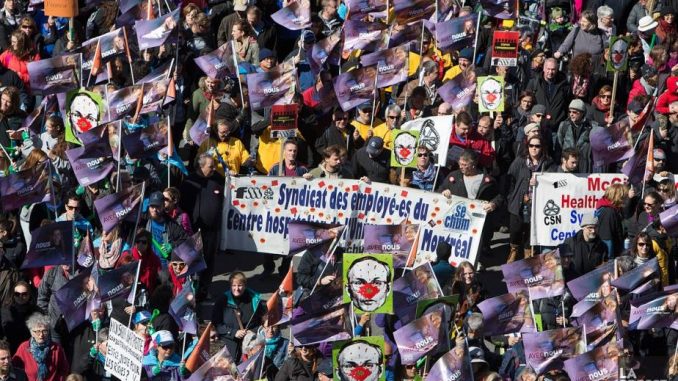
The collective wage agreements of more than half a million workers will expire on March 31, 2020. The various unions have to file their new applications by October 2019. So they are now beginning their discussions to determine their strategies and demands.
At the beginning of last February, the delegates of the Federal Council of the FSSS [Health and Social Services Federation], representing more than 90,000 low paid employees of the health network, unanimously voted for the reinstatement into their collective agreements of the automatic indexation of wages to the cost of living as one of the conditions for participating in a common inter-union front.
This proposal was brought by the SECHUM [union of workers from the Montreal university hospital] where Alternative Socialiste (CWI in Quebec) has been present for several years. This is a concrete way of defending low-paid public sector workers who have been systematically neglected for decades in past national negotiations.
A long struggle
Alternative Socialiste has campaigned for several years for the indexation of wages to the cost of living. Already during the campaign for “15+” initiated in 2014, AS defended the idea of a $15/h minimum wage as well as the indexation to the cost of living. Our petition, with the help of the Old Port Union, had amassed more than 22,000 signatures. Nevertheless, the union leaderships had done everything to silence the idea of indexation, and to spread out the wage increase to $15/h over several years, which resulted in the demobilization of the working class on this issue.
This time, we resume the offensive in the health sector. From the late 1960s to the mid-1980s, there was a mechanism in collective agreements for an annual indexation of wages based on the increase in the cost of living, based on the “consumption price index” (CPI). For example, in the FSSS convention for 1969-1971, article 25.05 mentions that “The employer adjusts the salary scales to take into account the increase in the cost of living, by taking as a reference the price index in the statistics for the Montreal area”. But subsequently, increases in line with the CPI were more and more abandoned, as the GDP was increasingly taken as the reference point. This has created for more than 30 years a growing gap between low-wage health care workers’ incomes and the real cost of living.
The index … AND the fixed amount
The SECHUM is also campaigning for another historic offensive demand from low-wage health workers: to link indexation to a fixed amount. That is, to set the wage demands in money rather than in percentages.
In all recent rounds of negotiations, the wage demands have been made in percentage. Proceeding in this way has two disadvantages. First, it widens the inequalities between the workers, whereas the “raison d’être” of the trade union movement is to reduce them. An increase of 1.5% when you are a psychologist who earns $ 80,000 a year does not represent the same amount than if you are a housekeeper and you earn about $ 35,000.
In addition, wage demands in percentage diminish the working class’ balance of power. In many cases, professionals are satisfied with their wage increases and accept them. For low wage earners, it’s a different matter, especially when the increase is constantly below the cost of living. In other words, over the long term, despite the increases, low earners are getting poorer.
Slowly but surely, this strategy has caused significant harm to low-income public sector workers, which we now need to redress. One way to do this is to return to a fixed wage increase as was done at the 1972 Common Front with the “$100 a week” demand and in 1976 with the “$165 a week” demand.
This question will be debated at the beginning of April. In those discussions, Alternative Socialiste will continue to actively promote militant demands and means of action for the trade union movement, and the need, at the same time, to lay the foundations for a clear political alternative for workers and youth in Quebec.
Special financial appeal to all readers of socialistworld.net |
Support building alternative socialist media Socialistworld.net provides a unique analysis and perspective of world events. Socialistworld.net also plays a crucial role in building the struggle for socialism across all continents. Capitalism has failed! Assist us to build the fight-back and prepare for the stormy period of class struggles ahead. Please make a donation to help us reach more readers and to widen our socialist campaigning work across the world. |
Donate via Paypal |
| M | T | W | T | F | S | S |
|---|---|---|---|---|---|---|
| 1 | 2 | 3 | ||||
| 4 | 5 | 6 | 7 | 8 | 9 | 10 |
| 11 | 12 | 13 | 14 | 15 | 16 | 17 |
| 18 | 19 | 20 | 21 | 22 | 23 | 24 |
| 25 | 26 | 27 | 28 | |||


Be the first to comment